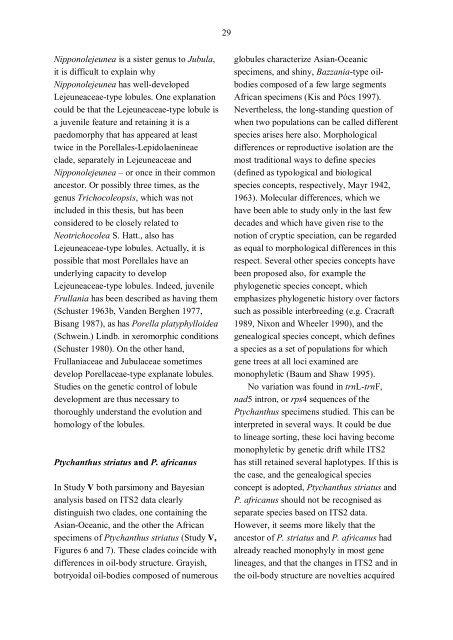Evolutionary relationships of liverworts with a special focus ... - Doria
Evolutionary relationships of liverworts with a special focus ... - Doria
Evolutionary relationships of liverworts with a special focus ... - Doria
Create successful ePaper yourself
Turn your PDF publications into a flip-book with our unique Google optimized e-Paper software.
29<br />
Nipponolejeunea is a sister genus to Jubula,<br />
it is difficult to explain why<br />
Nipponolejeunea has well-developed<br />
Lejeuneaceae-type lobules. One explanation<br />
could be that the Lejeuneaceae-type lobule is<br />
a juvenile feature and retaining it is a<br />
paedomorphy that has appeared at least<br />
twice in the Porellales-Lepidolaenineae<br />
clade, separately in Lejeuneaceae and<br />
Nipponolejeunea – or once in their common<br />
ancestor. Or possibly three times, as the<br />
genus Trichocoleopsis, which was not<br />
included in this thesis, but has been<br />
considered to be closely related to<br />
Neotrichocolea S. Hatt., also has<br />
Lejeuneaceae-type lobules. Actually, it is<br />
possible that most Porellales have an<br />
underlying capacity to develop<br />
Lejeuneaceae-type lobules. Indeed, juvenile<br />
Frullania has been described as having them<br />
(Schuster 1963b, Vanden Berghen 1977,<br />
Bisang 1987), as has Porella platyphylloidea<br />
(Schwein.) Lindb. in xeromorphic conditions<br />
(Schuster 1980). On the other hand,<br />
Frullaniaceae and Jubulaceae sometimes<br />
develop Porellaceae-type explanate lobules.<br />
Studies on the genetic control <strong>of</strong> lobule<br />
development are thus necessary to<br />
thoroughly understand the evolution and<br />
homology <strong>of</strong> the lobules.<br />
Ptychanthus striatus and P. africanus<br />
In Study V both parsimony and Bayesian<br />
analysis based on ITS2 data clearly<br />
distinguish two clades, one containing the<br />
Asian-Oceanic, and the other the African<br />
specimens <strong>of</strong> Ptychanthus striatus (Study V,<br />
Figures 6 and 7). These clades coincide <strong>with</strong><br />
differences in oil-body structure. Grayish,<br />
botryoidal oil-bodies composed <strong>of</strong> numerous<br />
globules characterize Asian-Oceanic<br />
specimens, and shiny, Bazzania-type oilbodies<br />
composed <strong>of</strong> a few large segments<br />
African specimens (Kis and Pócs 1997).<br />
Nevertheless, the long-standing question <strong>of</strong><br />
when two populations can be called different<br />
species arises here also. Morphological<br />
differences or reproductive isolation are the<br />
most traditional ways to define species<br />
(defined as typological and biological<br />
species concepts, respectively, Mayr 1942,<br />
1963). Molecular differences, which we<br />
have been able to study only in the last few<br />
decades and which have given rise to the<br />
notion <strong>of</strong> cryptic speciation, can be regarded<br />
as equal to morphological differences in this<br />
respect. Several other species concepts have<br />
been proposed also, for example the<br />
phylogenetic species concept, which<br />
emphasizes phylogenetic history over factors<br />
such as possible interbreeding (e.g. Cracraft<br />
1989, Nixon and Wheeler 1990), and the<br />
genealogical species concept, which defines<br />
a species as a set <strong>of</strong> populations for which<br />
gene trees at all loci examined are<br />
monophyletic (Baum and Shaw 1995).<br />
No variation was found in trnL-trnF,<br />
nad5 intron, or rps4 sequences <strong>of</strong> the<br />
Ptychanthus specimens studied. This can be<br />
interpreted in several ways. It could be due<br />
to lineage sorting, these loci having become<br />
monophyletic by genetic drift while ITS2<br />
has still retained several haplotypes. If this is<br />
the case, and the genealogical species<br />
concept is adopted, Ptychanthus striatus and<br />
P. africanus should not be recognised as<br />
separate species based on ITS2 data.<br />
However, it seems more likely that the<br />
ancestor <strong>of</strong> P. striatus and P. africanus had<br />
already reached monophyly in most gene<br />
lineages, and that the changes in ITS2 and in<br />
the oil-body structure are novelties acquired
















